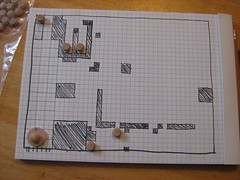Yes, I do.
I’m really close to moving the player around. He can jump in and out of the tank if he’s near it. Or, he will once I figure out how to make sure that he doesn’t jump out of the tank into a wall.
I made myself some scrambled eggs, sprinkled with a little pepper. Together with buttered wheat toast, a banana, and a glass of orange juice, it makes a fantastic breakfast. My compliments to the chef.
Gizmo also had some breakfast with me:
Ok, after I shower and get dressed, I’m cracking down on my game development. No more Mr. Nice Guy. Since getting this:
I haven’t done anything, and it’s time to do so. If it took me only 20 minutes to get the tank drawn and moving around, I’m sure I can probably get the rest of the mechanics in a matter of hours. I should have time to add sound effects before the end, something I haven’t done since LD#11, and then I can update the rough graphics, time permitting.
It’s times like these that I like to think of the lyrics from the hit TV show, Perfect Strangers:
No matter what the odds are this time
Nothing’s gonna stand in my way!
Either that, or I like to listen to electronica. Either way.
I had some time when I got to my parents’ house to pick up my father to go see the Chicago Fire game, so I decided to have some dinner:
Lemon chicken and potatoes!
We had great seats. 2nd row, right at the midfield! Unfortunately, the Fire lost 1-0 to D.C. United. Whatever.
When I got home, I had a bit of comfort food: American cheese singles in Italian bread.
It’s not much:
But that little box on the lower right side of the screen? It’s moving around. I figured I should have something interesting to show while the time lapse capture is running. I am now going to take a long break for the evening to watch the Chicago Fire kick D.C. United’s butt. I’ll take pictures if I find any interesting food there. B-)
After getting an SDL window to open and close when I tell it to, I decided to take a break for lunch:
There it is. My popular famous and award-winning peanut butter and pickle sandwich. I put cinnamon on it, as well. My lovely girlfriend sent me cookies for this competition, so I had one of those. And I washed the whole thing down with apple juice.
Now to get some progress on the game development before I leave for a Chicago Fire game tonight. There are 32 hours left in the competition.
It’s hard to type when a cat decides that NOW is the time to curl up in your lap, rubbing against your arm or face.
Usually Gizmo is the one who does this, but this time Diego decided to make an appearance. He really hammed it up when I got the camera out. Caption contest?
I’ve decided not to pursue Test Driven Development with this project. I can imagine that I will spend time on infrastructure more than anything, and Rule #1 of many Rule #1s for Ludum Dare is “Focus on making a game, not an engine for games.” I am still going to try to keep things focused and small, which is what TDD usually helps me with. What I won’t do is spend too much time on wrapping up hardware or libraries in testable code. I can spend hours on that alone, and I just don’t have the hours.
I just fear that the end of the contest will find me wishing I had unit tests in place because “I don’t have the hours” to not have them. B-)
I’m LD, and I win the fight!
After I showered, shaved, and got dressed, it was time to get down to business. Before any new code gets written, I had to make sure my ideas had a chance of being fun. First stop, paper prototypes!
Here’s a close up of the first pass:

I drew some walls, and I placed a few tokens down to represent minerals, the tank, and the driver. Actually, my initial pass didn’t even have walls really, but moving the tank with the driver, then moving the driver to the minerals to collect them, and then moving the minerals to the tank wasn’t very interesting by itself.
The walls made it more interesting because now the tank can’t move past them.
After a bit, I had a more fleshed out design:
Now I have a concept of monsters, their lairs, movable boulders, and selectively destructible floors.
Hmm…now that I’ve written it out, it sounds like I’m making something that might be too ambitious for this weekend.
Oh, well. Onward!
I woke up hours later than I wanted to, but that’s what you get when you spend the first night of Ludum Dare watching videos of games and playing other ones for inspiration . B-\
I had a simple breakfast:
Knowing that I want to participate in the Ludum Dare 2010 Swimsuit Calendar, I’ve been trying to lose weight. While I haven’t been pursuing my push ups routine in some time, I can still eat right. Go Lean with almond milk, 2 bananas, and a glass of good ol’ reliable orange juice start my morning right.